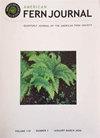北阿坎德邦喜马拉雅西部戈里谷蕨类植物和苔藓植物:一个案例研究
IF 0.9
4区 生物学
Q4 PLANT SCIENCES
引用次数: 2
摘要
摘要这项研究是在喜马拉雅西部北阿坎德邦的戈里河谷流域进行的,目的是更全面地记录蕨类植物和石松植物在山地的分布和生态,该山地被划分为7个海拔采样区,从1800–4000米(亚温带到高山),距离约30公里。共发现16科33属92种。计算了每个海拔带的物种丰富度、总物种密度ha–1、多样性和Pielou物种均匀度(m)。这些数据被用来评估三个假设,即密度和物种分布的变化与七个海拔采样区的生物地理和气候条件有关。蕨类植物和番茄属植物的总密度从1区向7区呈下降趋势;尽管1-3区(亚温带)的平均密度明显高于5-7区(高山)。密度最高的是1区(Lilam 1800 m),密度最低的是6区(Burfu 3450 m)。在使用非参数Welch方差分析发现每个海拔带的所有平均密度之间存在显著差异(p<0.001)后,对平均值进行成对比较的Games-Howell检验显示,1至3区物种的平均密度与5至7区物种的密度显著不同(p<0.05)。4区的平均密度和其他任何一个区平均密度(即1–3和5–7)没有显著差异,表明区域4是两个端部构件区域(1-3和5-7)之间的过渡区域。本文章由计算机程序翻译,如有差异,请以英文原文为准。
Ferns and Lycophytes of Gori Valley, Western Himalaya, Uttarakhand: A Case Study
Abstract. This study was carried out in the Gori Valley catchment of Uttarakhand, Western Himalaya, to document more fully the distribution and ecology of ferns and lycophytes at a montane site divided into 7 elevation sampling zones from 1,800–4,000 m (subtemperate to alpine) across a distance of approximately 30 km. A total of 16 families, 33 genera, and 92 species were found. Species richness, total species density ha–1, diversity, and Pielou's species evenness per elevation zone (m) were calculated for each zone. The data were used to evaluate three hypotheses addressing changes in density and species distribution in relation to the biogeographic and climatic conditions across the seven elevation sampling zones. Total density of ferns and lycophytes tended to decrease from Zone 1 toward Zone 7; although Zones 1-3 (sub-temperate) had clearly higher mean densities than those in Zones 5-7 (alpine). The highest density was found in Zone 1 (Lilam 1,800 m) and lowest density was found in Zone 6 (Burfu 3,450 m). After finding a significant difference among all mean densities for each elevation zone (p < 0.001), using a non-parametric Welch's ANOVA, a Games-Howell test for pairwise comparisons of the means showed that each of the mean densities for species in Zones 1 to 3 was significantly different from each of the species densities in Zones 5 to 7 (p < 0.05). The mean densities for Zone 4 were not significantly different from any of the other zonal mean densities (i.e., 1–3 and 5–7), suggesting that Zone 4 is a transitional zone between two end member Zones (1–3 and 5–7).
求助全文
通过发布文献求助,成功后即可免费获取论文全文。
去求助
来源期刊

American Fern Journal
生物-植物科学
CiteScore
1.20
自引率
0.00%
发文量
28
审稿时长
6 months
期刊介绍:
The American Fern Journal is a peer-reviewed journal focused on the biology of ferns and lycophytes.
 求助内容:
求助内容: 应助结果提醒方式:
应助结果提醒方式:


